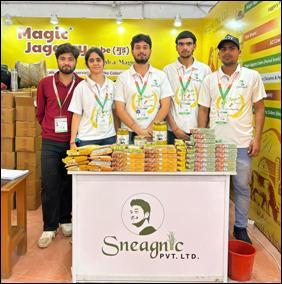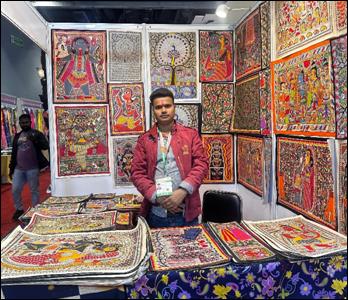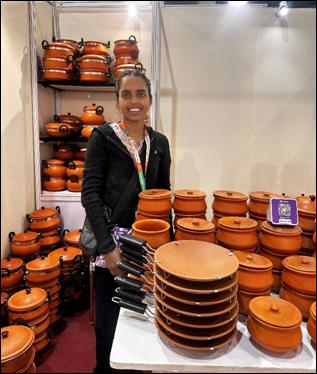Social Welfare
Tradition Meets Ambition
Youth Redefine India's Trade Fair Legacy
Posted On:
25 NOV 2025 11:15AM
Youth at the Heart of IITF 2025
At the 44th India International Trade Fair (IITF) in New Delhi, the theme “Ek Bharat Shreshtha Bharat” comes alive not only through the pavilions or the cultural programmes—but in the faces of the young artisans and entrepreneurs proudly standing behind their stalls. From Bijnor to Madhubani, Alwar to Kutch, and even from across the Mediterranean in Tunisia, the 2025 edition of IITF showcases a new generation whose ambition is reshaping the economic and cultural landscape of India and the world.
Across Bharat Mandapam’s wide corridors, these young participants are not merely selling products. They are carrying forward family legacies, reinventing traditional crafts, experimenting with new technologies, and charting entrepreneurial journeys of their own.
In their stories, one finds the lived expression of policies that promote MSME growth, skill development, rural livelihoods and global market linkages. Complementing these efforts is Mera Yuva Bharat (MY Bharat), a landmark initiative of the Government of India that provides young people with a dedicated platform to build leadership, pursue innovation, and translate their energy into meaningful action for nation-building.
At IITF 2025, these aspirations meet opportunity — giving young Indians a national and international stage on which to shape the country’s future.
The Jaggery Innovator from Bijnor, Uttar Pradesh

Hailing from Bijnor, one of India's largest sugarcane-producing districts, 26-year-old Naman Sharma embodies a new generation, determined to carry its legacy forward rather than leave it behind. His journey to becoming a young agro-entrepreneur began with a simple mission: “I want to modernise the jaggery industry and deliver chemical free and natural products.”
Born into a sugarcane-growing family, Naman wanted to stay rooted in his land even as his peers went abroad to study. In 2021, Naman formally registered his private limited company, even though he had already begun experimenting as early as 2018.
His younger brother (21) and sister (23) are his core team now and together they are creating rural livelihood opportunities by employing 15 factory workers and 25 women in the packaging unit.
This is his first IITF, and getting here wasn’t accidental. It came after strong responses at regional events- from Bijnor Mahotsav to Basant Mahotsav. Now, he is eyeing exports and applying for Prime Minister's Employment Generation Program (PMEGP) to advance his units.
The Madhubani Heir Carrying a Padma Shri Legacy
In the Bihar pavilion, the vibrant colours of Madhubani paintings catch the eye immediately, and at the heart of this display is 18-year-old Madhuram Kumar Jha from Jitwarpur, Bihar, a village synonymous with the art form itself.

His grandmother is no ordinary artist. She is Padma Shri Baua Devi, a national awardee and one of the leading figures of the Mithila tradition. Madhuram grew up observing her artistry and skills.
“When my grandmother used to paint, I would sit next to her, bringing whatever she asked for. I learned by watching her hands,” he says, recalling his earliest memories at the age of six.
His artistic career has already taken him to several states and expositions. Despite his busy schedule, Madhuram is still preparing for his exams. "I will start studying after the fair ends," he says earnestly.
He credits the pavilion for giving him visibility and a sense of identity: “The government has given us a name, a stage… because of my Dadi Maa.”
His dream is as expansive as his art- to take Madhubani to “every street, every country” and, eventually, to become an IRS officer or join the Indian Navy.
Madhuram is a reminder that cultural heritage thrives when embraced by the young, not as nostalgia, but as living, growing art.
The Young Potter Holding Up a Family Tradition
In the Rajasthan pavilion, rows of terracotta pots, glow under the warm lights. Among them stands 20-year-old Karishma Parjapat, soft-spoken yet confident, representing her family’s long-standing pottery craft.

“We break the clay, melt it, soak it… then my father shapes it and cooks it in a clay kiln,” she explains with the clarity of someone who has watched the process unfold all her life.
Karishma is pursuing her BA from Dausa district, while supporting her father, mother, sister, and two workers who handle the craft full-time. “We study at home, but we also help. It is our family’s work,” she says.
Their stall is sponsored by the Directorate Women Empowerment: “The government does not take money from us,” she notes. They apply whenever entries are invited, and her family has now been selected twice.
What stands out most about Karishma is the ease with which she moves between tradition and modernity, helping customers, explaining techniques, and speaking about her craft while balancing college life. Her presence reflects the growing visibility and influence of young women in India’s craft landscape.
At IITF, her family’s terracotta pieces are not just products, they are the imprints of Rajasthan’s soil shaped and carried forward by youthful hands.
An 800-Year Legacy Carried Forward by the Young
When Luhar Javed Abdulla, 26, speaks about his craft, he is recounting a history older than nations. "Our work is 800-900 years old, but our family's work has been around 400 years."

From Kutch, Gujarat, Javed makes copper bells, once known as Indian cowbells hung around cattle necks, now transformed into musical instruments, wind chimes, and doorbells.
His family business employs 20 people, most of them women, and their work has travelled far beyond India; a cousin regularly showcases their craft in exhibitions in the United States with excellent response.
Javed represents the artisan community that has learned to innovate from within tradition, customising products for modern needs while maintaining centuries-old metalworking techniques. For Javed, IITF is more than a marketplace, it is a cultural stage. Each softly ringing bell at his stall carries an echo of Kutch’s pastoral history, held and renewed by a young custodian of the craft.
Beyond Borders: The Young Faces of IITF’s International Pavilion
The international pavilion at IITF 2025 is a world in itself. This year, the fair is hosting 12 participating countries and together, they are showcasing how IITF has evolved into a global marketplace, connecting cultures, crafts, and young entrepreneurs across continents.

Amid these bustling foreign stalls stands 26-year-old Ahmad Shahid from Tunisia, offering Delhi a taste of North African craftsmanship. His display of hand-painted ceramics, olive-wood kitchenware, lamps and decorative pieces draws visitors with its earthy elegance—an aesthetic that mirrors the artisanal heritage of his homeland.
Ahmad grew up learning his family’s artistry and wishes to continue the legacy of his father. Today, he runs a small export-oriented enterprise, hoping to build long-term trade linkages. “People here ask a lot of questions… they want to know how we make things,” he smiles, noting how Indian visitors show genuine curiosity.
For international participants, IITF offers far more than footfall. It is a gateway to understand local tastes, meet wholesalers, explore cross-border collaborations, and position themselves within India’s booming handicraft and lifestyle market.
Youth as Engines of Transformation
IITF 2025 stands as a powerful reflection of Ek Bharat Shreshtha Bharat, not only through its pavilions but through the young participants who give the fair its energy and purpose. These youth- entrepreneurs, artisans, innovators, represent India’s diversity in its most vibrant form. Their work blends local knowledge with modern ambition, demonstrating how unity grows stronger when every region’s talent is recognised, nurtured and given space to flourish.
What makes their presence truly significant is the empowerment it symbolises. For many of them, IITF is their first major platform, an opportunity to showcase their skills, meet new audiences, understand markets and see their craft valued at a national and international level.
In their stories lies a simple truth: the spirit of Ek Bharat Shreshtha Bharat grows stronger when its youth are empowered—given platforms to dream, create, and lead. Their journeys remind us that India’s progress is shaped not only in big halls or grand pavilions, but in the determination of young citizens who shape the nation’s story with every craft, innovation and idea they bring to life.
Download in PDF
***
RK
(Features ID: 156181)
आगंतुक पटल : 113
Provide suggestions / comments